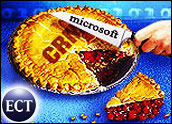
I was doing research for a book a few weeks ago when a friend recommended that I re-read Geoffrey Moore’s Inside the Tornado and I am glad she did. Tornado has to be about 10 years old now which puts it in a very interesting historical perspective. It’s old enough to have looked back on the amazing growth of companies like HP and its printer business, Oracle, Intel, and even DEC. But by the same token, enough time has gone by to show how useful many of Moore’s concepts were in forecasting the emergence of the CRM market.
One of the big ideas that hit me re-reading the book was the concept of infrastructure building. It was one of those things I had never really forgotten about, but it had become so ingrained in my own thinking that it had ceased to be part of my conscious analysis of certain situations.
Adapting to Change
Briefly, the idea is this. In lots of examples like PCs, databases, and even CRM, a concept is so new (a discontinuous innovation) that there is nothing like it, which means there is no true analog to replace. The idea of replacement is fundamental because the innovation can’t take over another niche. Effective use of the innovation means building an infrastructure for it.
For example, PCs might have physically replaced typewriters and dumb terminals on the desktop, but their effective use meant wiring buildings for LANs and conceiving new business processes that best took advantage of their unique capabilities. And, of course, it also meant writing the software that ran the networks, drove the printers, and provided security. No wonder early PC converts were hard pressed to show a return on the investment — the infrastructure investment was quite substantial. It wasn’t until the layoffs of the early 1990s, driven by the productivity increases of all those PC deployments, that we were finally able to clearly see the substantial ROI those deployments enabled.
All that got me thinking — a lot — about CRM and our obsession in the last few years with ROI for CRM.
The Early Days of CRM
There was not much in the way of front office software until the CRM revolution got started in the mid-1990s and what little there was usually was home grown software or shadow systems hosted on spreadsheets — the default application prototyping environment. CRM required most organizations to build significant infrastructure in the form of client-server systems, private networks, as well as other technology investments.
It should have been no surprise to anyone that the cost of CRM deployment was more than the cost of a software license, simply because so much infrastructure had to be bought and deployed. What also should have surprised no one was that CRM provided no ROI in the short term. Yet it was precisely that fact that rocked the industry when it was revealed that some of Siebel’s best customers could not prove ROI on their systems. If we’d all had our thinking caps on we would have uttered a collective, “Duh!” Instead we all ran around like Chicken Little and a new and very distracting parlor game came into being — “Find the ROI.”
Even more surprising was the way Siebel handled the situation: they didn’t really have a coherent statement. Instead, the discussion deteriorated into an argument with the IQ of a low calorie beer commercial. Even the ugly truth — that infrastructure takes a long time to pay back its investment — would have been preferable to what followed. Find the ROI played out everywhere; it launched countless analyst studies and news reports and kept a lot of people working in a down economy. An ocean of ink and countless electrons were sacrificed to the quixotic search for what never existed or rather, what had not come into being yet.
In truth, Siebel’s customers were simply revealing a well understood fact of discontinuous innovation that had been hiding in plain sight. You don’t get ROI right away on a discontinuous innovation simply because you are making such a big investment in infrastructure. That’s not to say that ROI will never come, the PC example above is proof. But in many cases it does mean that patience has to be exercised.
The On-Demand Miracle
But now the story takes a sharp turn and rather than waiting for the ROI to evolve, as was the case of the PC revolution, the cost of infrastructure miraculously disappeared or at least was sharply reduced. Along came hosted or on-demand CRM and the infrastructure requirements practically went away over night, at least in part because of the prior investment in PCs twenty years before — talk about long time horizons!
The on-demand revolution did a lot more than upset the CRM apple cart, it has changed the way we compute and its effects will be felt for quite some time as the industry gets used to a new computing paradigm and fortunes are made and lost depending on which side of the on-demand debate you find yourself on. But even more, the disruptive innovation we call on-demand also changed our expectations of return on investment. If we were impatient for ROI before, we’re just about adamant now that a provable return be evident almost immediately.
From one perspective, the on-demand revolution looks a lot like the invention of the telephone system. In that case — a true utility model — infrastructure building was the total responsibility of the phone company. From a financial perspective, there are many advantages to the utility model. As a utility, the customer simply uses what he or she needs and pays for it — though at a higher rate — since the infrastructure build-out has to be paid for the somehow.
Lastly there is the issue of creativity or innovation. To use the phone company example again, when the phone system finally began deregulation the standard phone was black — a blue phone would cost a fortune — all equipment was leased and there was no such thing as plugging third-party gear into the sacred network. Voice mail, answering machines, and wireless handsets were the stuff of Buck Rogers or Dick Tracy comics.
Taking the Next Step
In the last fifty years or so we have been through an enormously innovative time in the software industry in which we replaced just about every paper-based business process with an application. Maybe it’s time to consolidate our gains and wring out some of the costs associated with this latest infrastructure build out. So far the utility model applied to enterprise software looks to be a kinder and gentler approach than the phone system. Will the new model be an improvement? Time will tell. But it will be less costly and more reliable, two demands the industry has heard loud and clear.
Denis Pombriant is a well known thought leader in CRM and the founder and managing principal of the Beagle Research Group, a CRM market research firm and consultancy. Pombriant’s latest white paper, Adding Sales to the Call Center Agenda, summarizes his recent research in the call center industry. In 2003, CRM Magazine named Pombriant one of the most influential executives in the CRM industry. Pombriant is currently working on a book to be published next year. He can be reached at [email protected]
























































